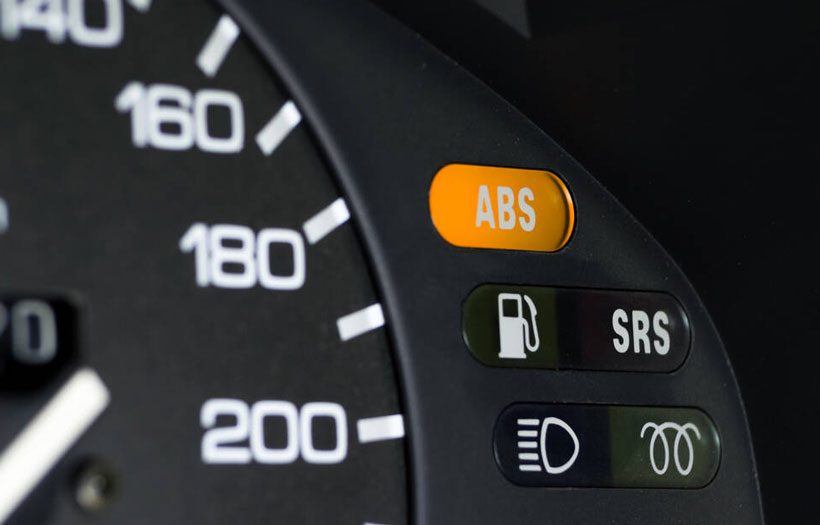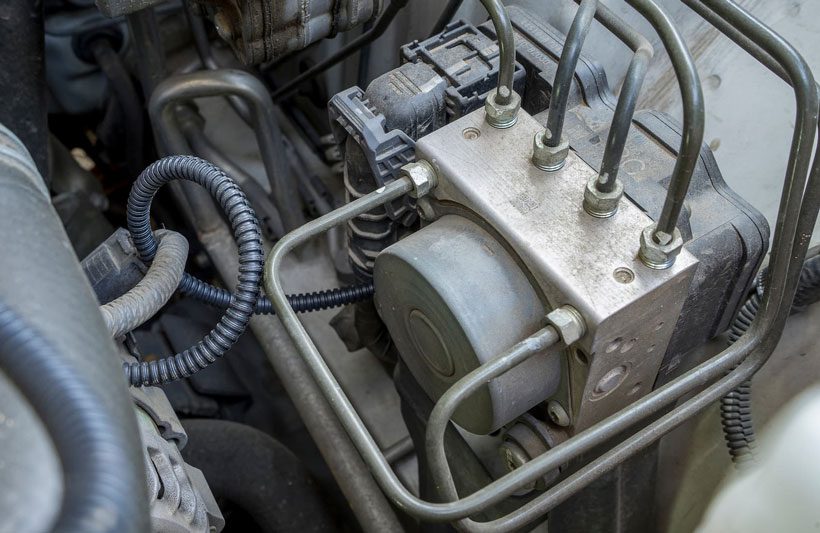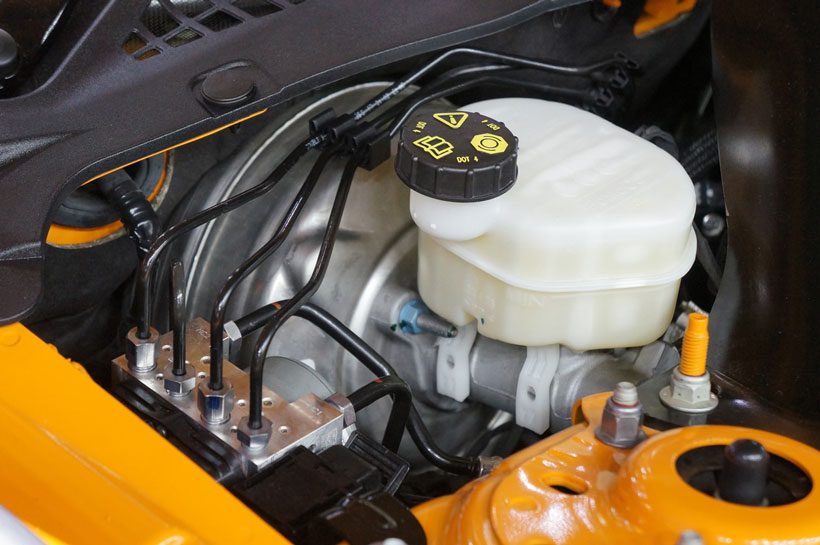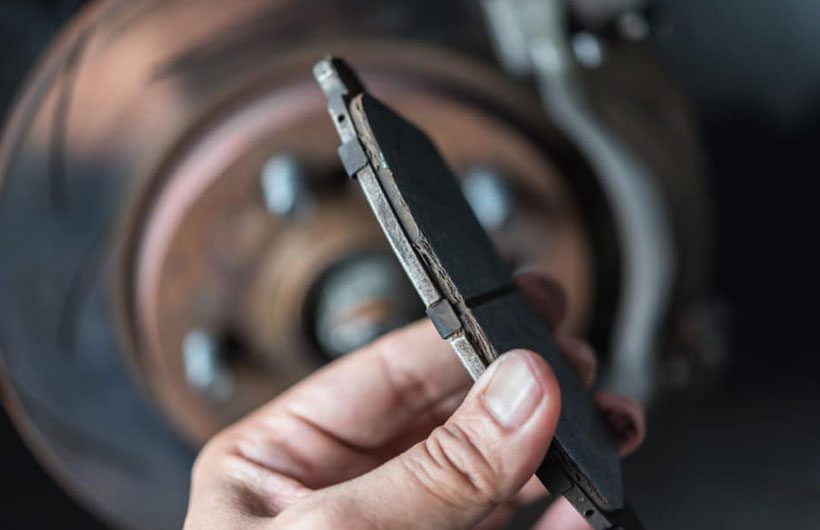Why Is My ABS Light On?
ABS, or Anti-lock Braking System, is a vital safety feature in modern automobiles. It helps avoid locking up the wheels when braking suddenly, particularly in slippery or wet conditions. If the ABS light on your vehicle’s dashboard illuminates, it indicates that there is an issue with the system.
So you ask, why is my abs light on? There could be various reasons; some of the common causes include-
- Ineffective ABS Module
- Faulty wheel speed sensors
- Low Brake Fluid Level
- Hydraulic Pump or Valve not responding
- Worn brake pads or rotors
However, this article will explore the reasons behind the ABS light being on. This will also discuss how to fix the problems of ABS light on issues. Without more ado, let’s start.
Why Is My ABS Light On? – Overview Of The Reasons With Quick Fixes

The common reasons and quick fixes are listed in the table below. Check it out here –
| No. | Common Reason | Quick Fix |
|---|---|---|
| 1 | Ineffective ABS Module | Replace ABS module |
| Repair the ABS module | ||
| 2 | Faulty wheel speed sensors | Replace the sensor |
| Clean the sensor | ||
| 3 | Low Brake Fluid Level | Refill the brake fluid |
| Clean the brake fluid reservoir | ||
| 4 | Hydraulic Pump or Valve Not responding | Replace the hydraulic pump or valve |
| 5 | Worn brake pads or rotors | Replace the worn brake pads or rotors |
Why Is My ABS Light On? Reasons And Solutions
Multiple reasons come into play behind the ABS light may come on. The reasons are as follows with their potential solutions.

1. Ineffective ABS Module
One of the most common reasons why the ABS light illuminates is issues with the ABS module. The ABS works combined with your vehicle’s traction control system (TCS). This traction control is a system that keeps all four wheels on the ground rolling smoothly.
When TCS detects irregular spinning, it will turn off your engine’s power until it gets back stable traction. The TCS and ABS systems use the same module, and this can sometimes lead to errors on your dashboard. This means that any issue with the TCS can result in the ABS light coming on.

Other Symptoms
- The brake pedal gets less responsive
- The brakes are getting locked during regular driving
- A crackling or clicking sound, especially while pressing the brakes
Solutions
Replace ABS module: The most common solution is to replace the ABS module entirely. The specialist will remove the old module and replace it with a new one, ensuring that it is adjusted correctly. Here are the steps to replace an ABS module:
Step 1: Find the ABS module. Under the hood, near the brake fluid reservoir, the ABS module is typically located.
Step 2: Disconnect the negative battery cable. By doing this, you will avoid any electrical shorts when working on the ABS module.
Step 3: The ABS module’s wiring harness should be disconnected. There will be a connector that the ABS module can plug into. To pry the connector loose, use a flathead screwdriver.
Step 4: Remove the mounting bolts that hold the ABS module in place. The ABS module will be fastened to the car with two or three fasteners. To remove the bolts, use a wrench.
Step 5: Carefully remove the ABS module from the vehicle. Be careful not to damage the ABS module itself or the wiring.
Step 6: Set up the fresh ABS module. To install the new ABS module, repeat the preceding steps.
Step 7: Connect the new ABS module to the wiring harness.
Step 8: Connect the negative battery cable.
Step 9: Set the ignition key to the ON position. The ABS light should turn off.
The cost of replacing an ABS control module typically ranges from $944 to $985. The cost of parts is estimated to be between $845 and $855, while labor costs are expected to be between $100 and $130.
Repair the ABS module: In some cases, it may be possible to repair the ABS module instead of replacing it. A skilled specialist can troubleshoot the issue and fix the problem with the module, saving money in this process.
The cost of repairing an ABS module can vary depending on the make and model of your car, as well as the severity of the damage. However, the average cost of repairing an ABS module is between $150 and $350. This includes both the cost of the parts and the labor to repair it.
2. Faulty wheel speed sensors
A speed sensor is installed on modern automobile wheels. Wheel speed sensors are a piece of hardware, located near each wheel, provides information to your car’s computer about the individual speeds of the wheels.
If the speed sensor notices one of the tires moving at an unusual speed. Then, the computer will send signals to TCS to adjust the pressure distribution between the wheels.
Sadly, a faulty or damaged speed sensor may not provide accurate information to the main computer system. So, when the car’s computer notices the error, it switches on the ABS light.

Other Symptoms
- The traction control light comes on
- The brake pedal pulsates while braking
- The lack of anti-lock brakes
- The speedometer fails to work
- Loss of Stability Control or Traction
Solutions
Replace the sensor: The sensor may need to be changed if it is worn out or damaged. Here are the steps to replace faulty wheel speed sensors:
Step 1: Find the wheel speed sensors. The wheel speed sensors are frequently located near the wheel hub. They will be small, round sensors with a wire coming out of them.
Step 2: Negative battery cable disconnected. If you do this while working on the wheel speed sensors, any electrical shorts will be avoided.
Step 3: Remove the speed sensors from the wheels. To remove the bolt holding the wheel speed sensor in place, use a socket or wrench. The sensor can be removed from the wheel hub when the bolt has been loosened.
Step 4: Install new wheel speed sensors. Check that the new sensor is properly aligned with the wheel hub. Then, use a wrench or socket to tighten the bolt that secures the sensor in place.
Step 5: Reconnect the negative battery cable.
Step 6: Check the ABS light after turning on the ignition. Once the new wheel speed sensors are installed, the ABS light should turn off.
The cost of replacing a faulty wheel speed sensor can vary depending on the make and model of your car. But normally, it ranges between $200 and $300.
This sum is divided into $100-$150 for labor and the same amount for purchasing the part. If you want a more specialized vehicle, you could end up paying up to $1,000.
Clean the sensor: The sensor might get clogged with dirt or trash, leading to a malfunction. The issue might be resolved by cleaning the sensor. Here are the steps to clean the wheel speed sensors:
Step 1: To safely remove the wheels, use a car jack to raise your vehicle. Remove the wheel from the car by loosening the lug nuts on the tire.
Step 2: Then locate the ABS sensor. Using a wrench, remove the bolt covering the ABS sensor.
Step 3: Blow canned air into the sensor’s location. Wipe dirt and debris from the sensor with a clean, dry microfiber towel. To gently remove tough dirt or rust, use a wire brush or file. If you want to do this, be careful because excessive cleaning may damage the sensor.
Step 4: Reposition the sensor so that the wire is exactly the same as it was before. Reverse the preceding steps.
A wheel speed sensor can be cleaned for between $100 and $200 on average.
3. Low Brake Fluid Level
The brake fluid is essential to the vehicle’s braking system, especially in the anti-lock brake system’s control over brake pressure.
A hydraulic braking system closes your brake pads and stops your car using the power of a cylinder pressing against a fluid. This means that your brake system needs a stable, continuous level of fluid.
However, if there is a gradual leak or the fluid goes away, the amount of fluid will drop and your brakes won’t work properly. Usually, sensors on your computer can detect this, and the ABS light will turn on.

Other Symptoms
- The brake warning light has illuminated your dashboard
- Brake fluid seems low, dirty, or discolored
- Spongy or low brakes
- Making a squealing sound when braking
Solutions
Refill and clean the brake fluid: When the brake fluid level is low, the first step is to refill it to the recommended level. Check the owner’s manual for the type of brake fluid recommended for the vehicle.
If the brake fluid reservoir cap is dirty, clean it to prevent debris from getting into the reservoir.
Here are the steps to refill and clean the brake fluid:
Step 1: Locate the reservoir for the brake fluid. The brake fluid reservoir is normally found under the hood of a car. There will be a cap on top of a transparent plastic container.
Step 2: Before opening the brake fluid reservoir to check the fluid level, clean the top and cap.
Step 3: If the liquid is low or discolored, continue. Use the appropriate brake fluid.
Step 4: With a fresh, dry rag, clean the reservoir and its top. Remove the reservoir cap and refill the reservoir with brake fluid. Be careful not to overfill the brake fluid reservoir. Overfilling the reservoir can cause the brake fluid to leak out and damage your car’s paint.
4. Hydraulic Pump or Valve not responding
Hydraulic pumps are an essential component of the braking system. These parts produce the required amount of pressure for the brake pads to work effectively to stop your car. If you want to stop your car, a hydraulic pump must deliver more force at higher speeds.
However, if the hydraulic pump or valve becomes damaged and not working properly, the ABS won’t work and the ABS warning light will turn on.

Solutions
Replace the hydraulic pump or valve: If the pump or valve is damaged or worn out, it may need to be replaced. Here are the steps to replace the hydraulic pump or valve:
Step 1: Disconnect the negative battery cable. By doing this, you’ll avoid any electrical shorts when working on the hydraulic pump or valve.
Step 2: Locate the hydraulic valve or pump. It will be a big metal cylinder with numerous hoses attached to it.
Step 3: Flow off the hydraulic liquid. This will stop the liquid from leaking. To catch the liquid as it drains, use a container.
Step 4: Remove the outdated valve or pump. A socket or wrench may be needed for this. Be careful not to damage the pump or valve when removing it. The pump or valve is delicate, so it is important to handle it with care.
Step 5: Set up the new valve or pump. Ensure that the replacement pump or valve is installed correctly and tightened. Be careful not to overtighten the new pump or valve. Overtightening can damage the pump or valve.
Step 6: Fill the hydraulic system with new fluid. Reconnect the negative battery cable.
The cost of replacing a hydraulic pump varies depending on several factors, including the pump’s size, complexity, and brand. The cost can vary from $500 to $3000 on average. If the pump is tiny and simple, replacing it could cost under $500.
5. Worn brake pads or rotors
The ABS system is designed to prevent your wheels from locking up when you apply the brakes. This can help you in keeping control of your vehicle when braking suddenly or on slippery surfaces.
When your brake pads or rotors are worn, your ABS light might come on because the ABS system relies on them to function properly. If your brake pads or rotors are worn, they may not be able to provide enough friction to stop your car effectively.

Symptoms
- Squealing or grinding noises when braking.
- Longer stopping distances.
- Vibrations through the brake pedal.
- Reduced braking power.
Solutions
Replacing worn brake pads or rotors can improve the performance of your brakes and extend the life of your rotors. It can also help to prevent accidents by ensuring that your brakes are able to stop your car quickly and safely. Here are the steps to Replace the worn brake pads or rotors:
Step 1: Park your car on a level surface and engage the parking brake. Loosen the lug nuts on the wheel you’ll be working on. Jack up the car and support it with jack stands.
Step 2: Remove the lug nuts and take off the wheel. To remove the old brake pads, use a brake pad tool.
Step 3: Check the brake rotors for signs of wear or damage. It is necessary to replace the rotors if they are bent or have grooves in them.
Step 4: Install the new brake pads or rotors. Make sure that the pads are installed correctly so that they will not rub against the rotors.
Step 5: Put back the wheel, then tighten the lug nuts. Lower the vehicle and remove the jack stands.
Brake pad replacement costs between $40 and $145 for all four wheels. Labor costs typically range from $90 to $130 per axle, for a total of between $130 and $275 per axle.
The price of a rotor ranges from $35 to $80. The cost of labor to change brake rotors and pads at a shop ranges from $155 to $200 per axle. When visiting a professional shop, the cost of the brake rotor and pad repair typically ranges from $240 to $500 per axle.
Is It Safe To Drive When The ABS Light Comes On?
The ABS light on your automobile indicates that there is a problem with the braking system. If you don’t fix this problem, driving your car can become dangerous.
Nevertheless, if your ABS light comes on its own, you can still drive to your destination because your regular brakes will function normally. Your brakes will still operate, but if you need to make an emergency stop, the ABS may not engage.

You must have a mechanic diagnose the ABS light problem as soon as possible if the light does not go out.
However, if both the ABS and brake warning lights illuminate at the same time, it means that your vehicle is no longer safe to drive. When it happens, you should use the brakes to bring your car to a stable stop while gradually reducing your speed.
If you’re wondering about the meaning of the ABS light in your car and whether it’s safe and legal to drive with the ABS light on, our article on driving with ABS light on – safety and legality provides important information on this topic. It explains the potential risks and legal implications associated with driving with the ABS light illuminated. Additionally, if you’re looking for a solution to reset the ABS light without a scan tool, our article on how to reset the ABS light without a scan tool offers helpful instructions to address the issue. By exploring these resources, you can gain insights into the ABS light’s meaning and make informed decisions regarding your vehicle’s safety and compliance.FAQs
Here are the answers to some of the most frequently asked questions about ABS system are as follows:
No, the ABS (anti-lock braking system) does not lock up your brakes. In fact, its purpose is to prevent the brakes from locking up during hard braking. The ABS system uses sensors to monitor the speed of each wheel and a control module to adjust the braking pressure to prevent the wheels from locking up.
When the system detects a wheel that is about to lock up, it rapidly pulses the brakes on and off. This allows the wheel to continue turning while maintaining steering control.
Yes, low tire pressure can result in an illuminated ABS light. When braking, the ABS system is in control of keeping the wheels on the ground. This indicates that one of your tires could not be properly inflated. This may also cause the ABS light to illuminate for a number of reasons.
Wheel speed sensors are installed in your automobile at each of the four wheels. These sensors track wheel speed and continuously provide this data to the ABS and traction control systems, which are managed by the vehicle’s ECU.
Yes, A low battery might cause the ABS light to turn on and have an impact on the overall performance of the car. The ABS light will come on because there is a loss of electrical power in the car.
However, a low battery should absolutely be taken into consideration as a potential cause.
Final Words
It is always preferable to regard the ABS warning light as urgent. This is how it comes to avoiding further damage to the car and putting your life and the lives of other road users in danger.
So, if you see your ABS light come on, don’t ignore it. Take immediate action to have your vehicle inspected and repaired by a qualified mechanic. This will not only ensure your safety on the road but also help to prevent more costly repairs in the future.

